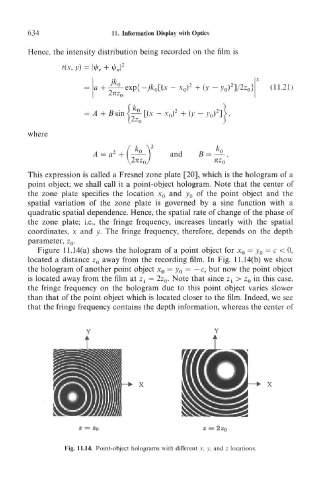Page 650 - Introduction to Information Optics
P. 650
634 11. Information Display with Optics
Hence, the intensity distribution being recorded on the film is
2
f(x, v) = |i// r + i// 0
2
2
ik ITv - Y \ 4- (r v I !/ (11.21)
J^OLV-^ A 0/ ^ v3' >()/ J/
(k 2 2 )
= A + B sin \-°- [(.x - x 0) + (v - y c)) ] >,
(2*0 j
where
+ ' and B==
This expression is called a Fresnel zone plate [20], which is the hologram of a
point object; we shall call it a point-object hologram. Note that the center of
the zone plate specifies the location x 0 and y 0 of the point object and the
spatial variation of the zone plate is governed by a sine function with a
quadratic spatial dependence. Hence, the spatial rate of change of the phase of
the zone plate; i.e., the fringe frequency, increases linearly with the spatial
coordinates, .x and y. The fringe frequency, therefore, depends on the depth
parameter, z ().
Figure 11.14(a) shows the hologram of a point object for x 0 — y 0 = c < 0,
located a distance z 0 away from the recording film. In Fig. 11.14(b) we show
the hologram of another point object x 0 = y 0 = — c, but now the point object
is located away from the film at z 1 = 2z 0. Note that since z i > z 0 in this case,
the fringe frequency on the hologram due to this point object varies slower
than that of the point object which is located closer to the film. Indeed, we see
that the fringe frequency contains the depth information, whereas the center of
X
Fig. 11.14. Point-object holograms with different x, y, and z locations.

